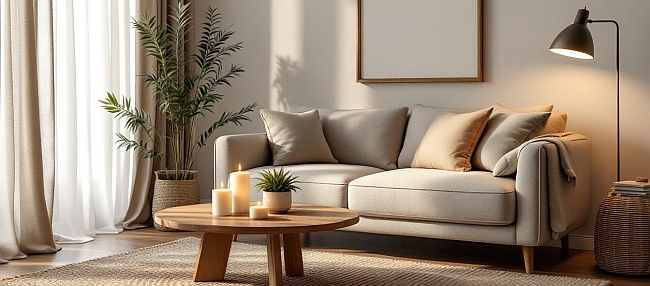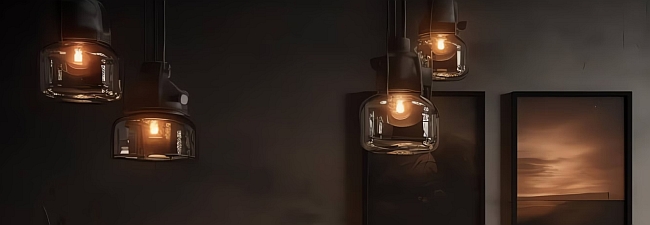Illuminate with Style Your Home: Creating the Perfect Ambiance
Transforming your home's lighting can significantly change its atmosphere. A well-lit room not only serves practicality but also enhances the overall aesthetic of your space. Let's dive into how you can illuminate with style and create an inviting mood for any occasion.

The Importance of Good Lighting
Good lighting is essential for every room in your house. It affects not only how functional a space is but also how comfortable it feels. Whether it's a cozy reading nook or a lively dining area, the right illumination can make all the difference.
There are multiple types of lighting to consider: ambient, task, and accent. Each has its role and contributes uniquely to the room's overall feel. Therefore, understanding these types is crucial before making any lighting decisions.
Ambient Lighting
Ambient lighting provides general illumination. It’s the base layer that ensures the room is adequately lit so you can see and move around comfortably. Common sources of ambient lighting include ceiling lights, chandeliers, and wall-mounted fixtures.
To create effective ambient lighting, consider using warm bulbs, which offer a cozy glow. This type of lighting works best in living rooms, bedrooms, and dining areas where comfort is paramount.
Task Lighting
Task lighting is more focused and is intended to light up specific areas where activities such as reading, cooking, or working take place. Desk lamps, under-cabinet kitchen lights, and vanity lights are prime examples of task lighting.
Choose brighter bulbs for task lighting to reduce eye strain and improve visibility. Adjustable floor lamps can add flexibility, allowing you to direct light exactly where it's needed most.
Accent Lighting
Think of accent lighting as the cherry on top. It's used to highlight particular features or add drama to a room. Picture lights, track lighting, and recessed spotlights often fall under this category.
Accent lighting helps draw attention to artwork, architectural elements, or other focal points within a room. For instance, using spotlights to illuminate a piece of art enhances its visual impact.
Choosing the Right Lamps and Fixtures
When selecting lamps and light fixtures, consider both function and design. The right choice will not only provide adequate illumination but also complement your interior décor.
Lamps and lighting fixtures come in a variety of styles, ranging from modern and minimalistic to classic and ornate. Your selection should align with the overall theme of your home. Here are key considerations:
- Table Lamps: Ideal for side tables, desks, or nightstands. They provide localized light and can be moved easily if needed.
- Floor Lamps: Offer versatility and are great for filling empty corners or providing extra light next to a sofa.
- Chandeliers: Perfect for adding elegance to dining rooms and entryways. Choose a size proportionate to the room for the best effect.
Creating Mood Lighting
Mood lighting focuses on creating a specific atmosphere rather than just illuminating a room. It’s about using softer, diffused lights to evoke certain feelings or set a tone for the space. Dimmers and smart bulbs can play a vital role in achieving the desired ambiance.
Incorporate mood lighting by alternating between different sources and intensities. For example, use sconce lights to cast gentle shadows on walls or fairy lights to add a whimsical touch to a bedroom. Experimenting with color temperatures can also influence the room's vibe—cooler tones invigorate, while warmer shades promote relaxation.

Strategic Placement of Light Sources
The arrangement and placement of light sources can dramatically alter the look and feel of a room. Poorly positioned lights can create unwanted shadows and make spaces seem smaller or less welcoming. On the other hand, strategically placed lights enhance the room's functionality and aesthetics.
Consider layering your lighting. Combining ambient, task, and accent lights allows for adjustable brightness levels suited to various activities and times of day. Position floor lamps in corners to brighten dark spots, and hang pendants over dining tables to define the space beautifully.
Using Natural Light
Don't overlook the power of natural light. It can elevate a room’s appeal by bringing out colors and textures naturally. Maximize daylight exposure by choosing light curtains or blinds that allow sunlight in while still offering privacy.
Position mirrors opposite windows to reflect light back into the room, making it appear more spacious and bright. Skylights and large windows can flood your interiors with daylight, reducing reliance on artificial sources during daytime hours.
Lighting for Small Spaces
Small spaces require thoughtful lighting strategies to avoid feeling cramped or cluttered. Opt for wall-mounted fixtures that save valuable floor space while providing ample illumination. Recessed lights also work wonders in low-ceiling areas.
Avoid overly bulky lamps; instead, choose sleek designs that blend seamlessly with the décor. Multi-functional pieces like illuminated shelving units serve dual purposes, enhancing storage while also lighting the room.
Innovative Lighting Trends
Keeping up with the latest lighting trends can inspire fresh ideas for your home. From energy-efficient solutions to artistic statement pieces, there’s always something new to explore.
Smart lighting systems allow for remote control via apps, enabling you to adjust settings effortlessly. Customizable LED strips can be installed virtually anywhere—from under cabinets to behind televisions—adding vibrant pops of color or subtle highlights.
Sustainable Options
Sustainability is at the forefront of current trends, including eco-friendly lighting choices that reduce energy consumption without compromising style. LED bulbs are one of the most popular sustainable options due to their long life span and low power usage.
Solar-powered lights for outdoor spaces capitalize on natural resources, ensuring your garden or patio stays beautifully illuminated while being kind to the environment. Pair these with timers or motion sensors to increase efficiency and security.
Artistic Fixtures
For those looking to make a bold statement, artistic fixtures serve as both functional pieces and works of art. Unique designs featuring unconventional shapes, materials, or patterns can transform a simple room into a visually stunning space.
Choosing a striking chandelier or bespoke pendant light can become the centerpiece of your living room or hall. Handcrafted lamps bring character and craftsmanship into your home, highlighting individuality and taste.
Final Touches and Accessories
The finishing touches are what tie the room together. Accessories like lampshades, dimmer switches, and smart controls can tailor the ambiance according to your preferences and needs.
Stylish lampshades can filter lights softly while adding decorative value. Dimmer switches offer flexibility in creating different moods or adjusting brightness based on tasks. Incorporating smart home technology makes controlling your lighting convenient, especially through voice commands or preset schedules.
Personalizing Your Lighting
Personalization adds a unique touch to your home lighting setup. Consider integrating custom fixtures that reflect your style or tailoring existing ones with DIY modifications. Changing bulb colors or repositioning lamps can continually refresh the ambiance.
Whether you're aiming for a modern look with sleek metal fixtures or a rustic charm with reclaimed wood designs, the possibilities are endless. Adding personal flair ensures your home feels truly yours—a sanctuary perfectly lit to suit your lifestyle and tastes.
Combining Aesthetics with Function
Finding the balance between aesthetics and function is key to a successful lighting plan. While it’s important to select beautiful fixtures, they must also meet the practical requirements of the space. Ensure adequate lighting for work areas without sacrificing style.
Reflect on how each piece will be used daily, then evaluate if it fits your home's overall theme. Merging beauty with practicality creates a harmonious environment that is both attractive and operationally effective.
